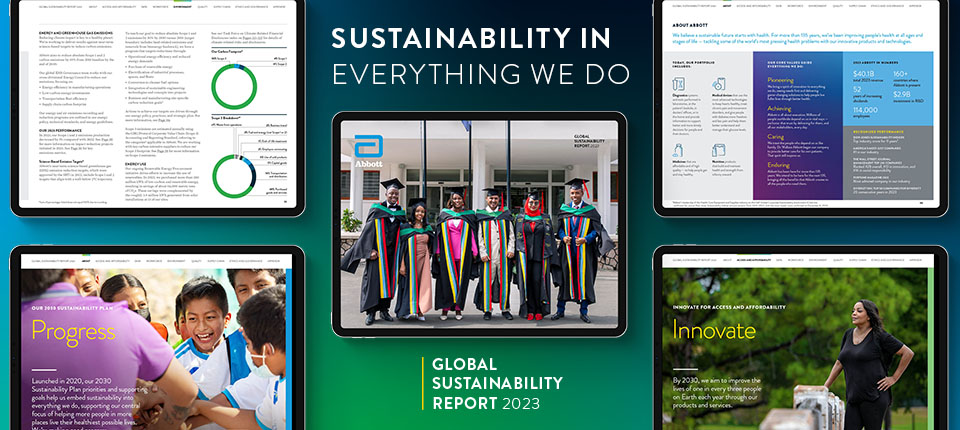Innovating for a Healthier, Sustainable Future
Abbott's 2023 Global Sustainability Report highlights the company's progress towards its 2030 Sustainability Plan goals. The report focuses on improving global health access and equity, reducing environmental impact, and fostering workforce development.
Key achievements include the introduction of the AVEIR DR leadless pacemaker, collaborations to expand biosimilar medicines in emerging markets, and emergency medicine initiatives in Tanzania. Environmental efforts saw a 7% reduction in emissions, a 3% decrease in water use, and high waste diversion rates. Workforce initiatives aim to double the targets for job opportunities and STEM training by 2030.
For detailed information, readers are encouraged to review the full report.
- Introduction of AVEIR DR, a groundbreaking leadless pacemaker
- Agreement to expand access to biosimilar medicines in emerging markets
- Expanded emergency medicine reach in Tanzania, benefiting 1.3 million patients
- 7% reduction in Scope 1 and 2 emissions
- 3% reduction in water use
- 91% operational waste diversion from landfills
- Doubling targets for job opportunities and STEM training by 2030
- Potential adverse events related to the Aveir Leadless Pacemaker, including cardiac perforation, infection, and device malfunction
Abbott's Global Sustainability Report shares how we're focused on helping more people, now and in the years ahead.
NORTHAMPTON, MA / ACCESSWIRE / June 25, 2024 / At Abbott, we've embedded sustainability across our business - which is helping us to deliver solid progress toward the goals we set in our 2030 Sustainability Plan. From our priority of innovating for greater access in health, to protecting a healthy environment, to building the diverse, innovative workforce of tomorrow, our 2023 Global Sustainability Report highlights progress toward our goal of improving the lives of 3 billion people each year by the end of the decade.

Innovating for Access and Equity
Innovation without access is meaningless. This is why we work so hard to ingrain access and affordability into our products at every stage of development and remove the barriers that stand in the way of good health, evolving the way we invent and bring technologies to the people who need them. A few highlights of our work in 2023:
- In the last year, we further incorporated our Access and Affordability Design Principles into our R&D, manufacturing and commercialization processes across our businesses.
- Because more than
80% of people who need a pacemaker require pacing in two chambers of the heart (both the right atrium and the right ventricle), we introduced AVEIR DR, the world's first device to offer beat-to-beat wireless communication and synchronization between two leadless pacemakers, each of which is smaller than a triple-A battery. AVEIR DR opens access to leadless pacing for millions of people. - We announced an agreement that will provide greater access to biosimilar medicines for more people in key emerging markets, together with global biotech leader mAbxience.
- In Tanzania, we worked with the government to expand the reach of emergency medicine - the latest results from more than 20 years of partnership. To date, we have provided emergency care services to nearly 1.3 million patients there. The cover of this year's report features the program's 2023 graduates in emergency medicine, reflecting our ongoing commitment to building local healthcare capacity.
- In the U.S., we worked with the National Association of Community Health Centers (NACHC) to launch an Innovation Incubator, helping eight health centers to find new ways to address the digital divide and advance care for more than 45,000 people in their communities.
Reducing Our Environmental Footprint
Advancing health also means doing our part to improve the health of the planet. Across Abbott, we completed 102 projects to help address our environmental impacts at 45 sites across 20 countries. We achieved a
Building the Workforce of Tomorrow
Our ability to build a healthy, sustainable future depends on the innovative ideas, execution and dedication of our global workforce, and this year's report shares updates those efforts. In our original 2030 plan, we had targets to create 1 million development and job opportunities for current and future employees, and to create opportunities in STEM programs and internships for 100,000 young people. In 2023, we were already exceeding our expected progress - so we're now doubling those goals for 2030.
See our full 2023 Global Sustainability Report for more details on these areas - and to learn more about how we responsibly connect data, technology and care, strengthen our global supply chain and ensure product quality.
IMPORTANT SAFETY INFORMATION
AVEIR™ DR
Rx Only
Brief Summary: Prior to using these devices, please review the Instructions for Use for a complete listing of indications, contraindications, warnings, precautions, potential adverse events and directions for use.
Indications: The Aveir™ Leadless Pacemaker system is indicated for management of one or more of the following permanent conditions: Syncope, Pre-syncope, Fatigue, Disorientation. Rate-modulated pacing is indicated for patients with chronotropic incompetence, and for those who would benefit from increased stimulation rates concurrent with physical activity. Dual-chamber pacing is indicated for patients exhibiting: Sick sinus syndrome, Chronic, symptomatic second- and third-degree AV block, Recurrent Adams-Stokes syndrome, Symptomatic bilateral bundle-branch block when tachyarrhythmia and other causes have been ruled out. Atrial pacing is indicated for patients with: Sinus node dysfunction and normal AV and intraventricular conduction systems. Ventricular pacing is indicated for patients with: Significant bradycardia and normal sinus rhythm with only rare episodes of AV block or sinus arrest, Chronic atrial fibrillation, Severe physical disability.
Intended Use: The Aveir™ Leadless Pacemaker (LP) is designed to provide bradycardia pacing as a pulse generator with built-in battery and electrodes for implantation in the right ventricle and/or right atrium. The LP is intended to provide sensing of intrinsic cardiac signals and delivery of cardiac pacing therapy within the implanted chamber for the target treatment group. The LP is also intended to operate optionally with another co-implanted LP to provide dual-chamber pacing therapy.
The Aveir™ Delivery Catheter is intended to be used in the peripheral vasculature and the cardiovascular system to deliver and manipulate an LP. Delivery and manipulation includes implanting an LP within the target chamber of the heart.
Contraindications: Use of the Aveir™ Leadless Pacemaker is contraindicated in these cases:
- Use of any pacemaker is contraindicated in patients with a co-implanted ICD because high-voltage shocks could damage the pacemaker and the pacemaker could reduce shock effectiveness.
- Single-chamber ventricular demand pacing is relatively contraindicated in patients who have demonstrated pacemaker syndrome, have retrograde VA conduction, or suffer a drop in arterial blood pressure with the onset of ventricular pacing.
- Programming of rate-responsive pacing is contraindicated in patients with intolerance of high sensor driven rates.
- Use is contraindicated in patients with an implanted vena cava filter or mechanical tricuspid valve because of interference between these devices and the delivery system during implantation.
- Persons with known history of allergies to any of the components of this device may suffer an allergic reaction to this device. Prior to use on the patient, the patient should be counseled on the materials (listed in the Product Materials section of the IFU) contained in the device and a thorough history of allergies must be discussed.
Adverse Events: Potential complications associated with the use of the Aveir™ Leadless Pacemaker system are the same as with the use of single or dual chamber pacemakers with active fixation pacing leads including, but not limited to: Cardiac perforation, Cardiac tamponade, Pericardial effusion, Pericarditis, Valve damage and/or regurgitation, Heart failure, Pneumothorax/hemothorax, Cardiac arrhythmias, Diaphragmatic/phrenic nerve stimulation / extra-cardiac stimulation, Palpitations, Hypotension, Syncope, Cerebrovascular accident, Infection, Hypersensitivity reaction to device materials, contrast media, medications, or direct toxic effect of contrast media on kidney function, Pacemaker syndrome, Inability to interrogate or program the LP due to programmer or LP malfunction, Intermittent or complete loss of pacing and/or sensing due to dislodgement or mechanical malfunction of the LP (non-battery related), Loss of capture or sensing due to embolization or fibrotic tissue response at the electrode, Increased capture threshold, Inappropriate sensor response, Interruption of desired LP function due to electrical interference, either electromyogenic or electromagnetic, Battery malfunction/ premature battery depletion, Device-related complications (Premature deployment, Device dislodgement/embolization of foreign material, Helix distortion), Death. As with any percutaneous catheterization procedure, potential complications include, but are not limited to: Vascular access complications; such as perforation, dissection, puncture, groin pain, Bleeding or hematoma, Thrombus formation, Thromboembolism, Air embolism, Local and systemic infection, Peripheral nerve damage. General surgery risks and complications from comorbidities; such as hypotension, dyspnea, respiratory failure, syncope, pneumonia, hypertension, cardiac failure, reaction to sedation, renal failure, anemia, and death.
MAT-2306873 v1.0 | Item is approved for US Use
View additional multimedia and more ESG storytelling from Abbott on 3blmedia.com.
Contact Info:
Spokesperson: Abbott
Website: https://www.3blmedia.com/profiles/abbott
Email: info@3blmedia.com
SOURCE: Abbott
View the original press release on accesswire.com
FAQ
What advancements has Abbott made in medical technology in 2023?
How is Abbott expanding access to biosimilar medicines?
What environmental achievements did Abbott report in 2023?







